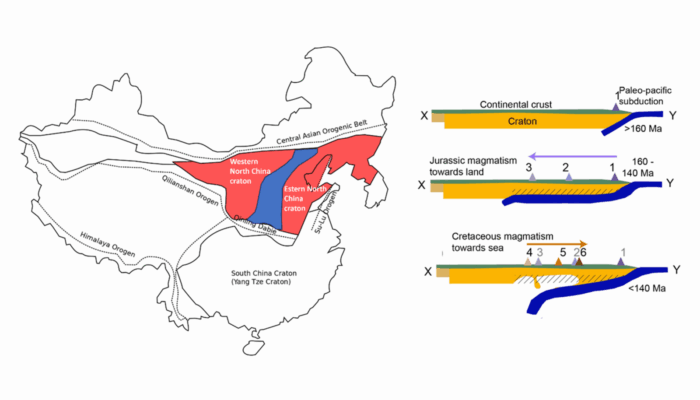
Cratons are forever, until they are not. These long-lived portions of lithosphere are known for being remarkably stable. However, if the conditions are right, even cratons can be ripped apart by geological forces, with far-reaching impacts on Earth’s systems. This week, Jyotirmoy Paul from the University of Oslo, Norway will tell us the downfall of the North China Craton, using numerical simulations to explore how a craton’s destruction unfolds and what processes drive it.

Jyotirmoy Paul is a Marie Skłodowska-Curie postdoctoral Fellow at the Centre for Planetary Habitability, University of Oslo. He develops numerical models of mantle convection and lithosphere dynamics with a particular interest to understand the evolution of continental cratons. You can find his research and artistic works at: https://jyotirmoyp.github.io/
Cratons are strong, old, and usually the most stable parts of lithosphere, unshaken by the drama of plate tectonics. These billion-year-old chunks of continental lithosphere are the VIPs of geological stability, often far from plate boundaries and earthquake zones. But sometimes, even the toughest cratons are destroyed under certain geological circumstances.
The North China Craton (NCC), shown in the cover image, was stable for roughly 3 billion years, until the Jurassic and Cretaceous changed its fate. Around 160 Ma, intensive carbonatite magmatism (that is, rich in carbonate minerals) intruded the cratonic crust. Xenoliths (tiny foreign rocks scavenged from the deep) reveal that the old, thick lithosphere got replaced by younger mantle. Seismic data also confirm that the NCC’s eastern half is completely destroyed.
Cratons are equipped with typically thick, cold, and strong (highly viscous) lithospheres that can resist the tectonic forces of destruction. So, most cratons stay strong, but some, like the NCC, have a different story! For example, the Indian craton was probably thinned but not completely destroyed. Such a phenomenon is called craton thinning (Paul et al., 2022). The Slave craton in Canada had a similar thinning, but it regained the original thickness by “recratonization” (Li et al., 2021). When the thick root of a craton is destroyed, intensive magmatism intrudes the crust, and stability is lost, we call it full-blown craton destruction (Wu et al., 2019).
The big question: How does a craton, built to last, suddenly fall apart?
Scientists have thrown around plenty of theories:
- Thermal weakening associated destruction/thinning.
- Hydration weakening associated destruction/thinning.
- Lower crust foundering.
- Delamination along mid-lithospheric weak zones.
Images tell better! Just look at Fig. 1. But which one fits the NCC’s dramatic demise?
To test these ideas, we modelled the NCC’s destruction through 2D numerical simulations (using a finite difference code, LaMEM, and a geometry generator tool, Geomio). Our setup mimicked Jurassic subduction, focusing on how a low-angle to flat slab could weaken the craton.
Here’s what we found:

Fig. 2. Snapshots of the NCC destruction from reference model M2 (Paul et al., 2025) after 9 Myr (a,b), 23 Myr (c,d) and 30 Myr (e,f) respectively. Background colours in (a,c,e) represent geological units which are indexed in the top right. The dark blue region indicates the weak craton which is forming lithospheric drips. White lines indicate isotherms. Background colours in (b,d,f) represent viscosity and the arrows represent velocity (Figure taken from Paul et al., 2025).
- Hydration is key. Hydration weakening is modelled by changing the craton’s rheology from dry olivine to weak olivine (dark blue regions in Fig. 2 a, c, e) which dropped craton viscosity below 10²² Pa·s. Viscosity reduction is the key aspect of subsequent destruction.
- Weak + dense = destruction. If the craton gets just weak enough and isn’t lighter than the surrounding mantle, it collapses in 20-30 million years, a geological blink compared to its billion-year lifespan (Fig. 2).
- No destruction without weakening. Without hydration, even dense crust or weak mid-lithosphere layers couldn’t trigger a craton’s downfall.
Our models point to hydration weakening as the prime reason in rapid craton destruction. But we still don’t know the fluid sources. The water could come from:
- Slab dehydration (the usual suspect).
- Mantle transition zone (the mysterious deep source).
Whatever the main source could be, the NCC’s extensive carbonatite magmatism probably created fractures for fluid transport by rapidly reacting with lithospheric pyroxenites. And that caused a catastrophic destruction of the NCC.
Some researchers argue flat slabs might not form in this region. So, we tested both scenarios with low angle and high angle slab geometry. We found that the flat slab rollback perturbs the mantle vigorously and can rapidly destabilize a weak craton.
The destruction of the NCC had a broader impact on local and global Earth systems.
- CO₂ release: The NCC’s destruction unleashed massive amounts of CO₂, possibly contributing to the Cretaceous global warming. (Wang et al., 2022)
- Topography Flip: Prior to destruction, the NCC blocked Pacific moisture from the east. After the craton’s demise, topography reduced, and δ18O values from garnets show a sudden shift from meteoric to seawater signatures, which means the ocean breezes from the Pacific finally made it inland (Fig. 3).
- Biogeography distribution: The Jehol Biota (fancy dinosaurs and early birds) moved towards east when the NCC’s landscape changed.

Fig. 3: Before the destruction of craton, high topography obstructed the Pacific moisture to enter inland. After destruction, topography reduced and the Pacific moisture entered, and biota moved towards east (Figure adapted from Wang et al., 2024).
The NCC’s destruction was likely a hydration-induced collapse, sped up by carbonatite magmatism opening fluid pathways. So, Earth’s most stable regions aren’t invincible. Sometimes all it takes is some water, heat, and tectonic bad luck to turn a billion-year-old craton into a cautionary tale.
References: [1] Liu, J., Pearson, D.G., Wang, L.H., Mather, K.A., Kjarsgaard, B.A., Schaeffer, A.J., Irvine, G.J., Kopylova, M.G. and Armstrong, J.P., 2021. Plume-driven recratonization of deep continental lithospheric mantle. Nature, 592(7856), 732–736. https://doi.org/10.1038/s41586-021-03395-5 [2] Paul, J. and Ghosh, A., 2022. Could the Réunion plume have thinned the Indian craton? Geology, 50(3), 346-350. https://doi.org/10.1130/G49492.1 [3] Paul, J., Spang, A., and Piccolo, A., 2025. Hydration weakening and destruction of the North China Craton. Tectonophysics, 230756. https://doi.org/10.1016/j.tecto.2025.230756 [4] Wang, Z.X., Liu, S.A., Li, S., Liu, D., and Liu, J., 2022. Linking deep CO2 outgassing to cratonic destruction. National Science Review, 9(6), nwac001. https://doi.org/10.1093/nsr/nwac001 [5] Wang, W., Chu, X., Zhang, J., Cui, Y., Chen, X., Wang, Y., and Su, S., 2024. The climatic pattern of East Asia shifted in response to cratonic thinning in the Early Cretaceous. Communications Earth & Environment, 5(1), 728. https://doi.org/10.1038/s43247-024-01841-6 [6] Wu, F.Y., Yang, J.H., Xu, Y.G., Wilde, S.A., and Walker, R.J., 2019. Destruction of the North China craton in the Mesozoic. Annual review of earth and planetary sciences, 47(1), 173-195. https://doi.org/10.1146/annurev-earth-053018-060342




